Moffett Field
The following text is from the pamphlet Moffett Field 60th Anniversary, 1933-1993:
"The creation of Moffett Field is a story linked to the birth of a new period in American aviation - the lighter-than-air craft era - which began with an idea about 70 years ago. Germany had found success in using giant airships for scouting purposes during World War 1, and the U.S. did not want to be left behind. These were the days before radar, and dirigibles had the capacity to scout large areas of land or sea for long periods, longer than any other aircraft at the time. At first, the Navy had just two rigid dirigibles, the most famous being the USS Shenandoah. But the career of the Shenandoah, as with many of its predecessors, was short-lived. The cigar-shaped airship was torn apart in a severe thunderstorrn over Ohio on Sept. 3, 1925, claiming the lives of 14 officers and crewmen. The demise of the ship added fuel to a growing controversy about the military effectiveness of dirigibles.
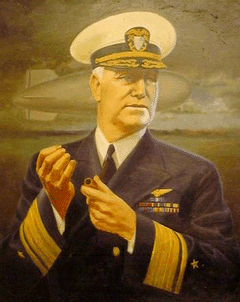 Admiral William A. Moffett
Admiral William A. Moffett
|
"When I first came in contact with rigid airships, I couldn't see anything to them," said Rear Admiral William A. Moffett, chief of the Navy's Bureau of Aeronautics in 1926. "It is noteworthy that every officer who has anything to do with these ships ... is in favor of them and thinks they will be of great value to the Navy." The advocates of this new-found technology won out. In 1926, the Navy announced that it was going to build two new airships, both larger and stronger than the Shenandoah. They would become the Akron and the Macon.
The Navy quickly launched a search for a West Coast place to base one of the two ships. Navy officials initially appeared to favor Camp Kearny in San Diego. In an attempt to better their chances of receiving the base, Santa Clara, San Mateo, San Francisco and Alameda counties set up a financing program to buy the land and donate it to the Navy for the purposes of building an air base. San Francisco raised $330,000, while Santa Clara County communities contributed most of the remaining $ 100,000 to buy the land. The communities eventually purchased 1,000 acres of the bayside property for $476,066. Still the Navy had not made up its mind. After discarding dozens of possible West Coast sites, the choice was between Camp Kearny and the Bay Area. The competition between the two regions was fierce. San Diego newspapers claimed the Bay Area site was too foggy. Camp Kearny was criticized for having too much heavier-than-air traffic and being vulnerable to attack from many directions. The competition ended in December. Two months later, President Herbert Hoover, himself a product of Stanford University, signed the bill that authorized the Navy to accept the Mountain View property for one dollar and appropriated $5 million for construction on the base to begin as soon as possible. Noted a San Francisco Chronicle editorial at the time: "What has been done with Sunnyvale is an example of what Northern and Central California can do when they play the game." This game, the Bay Area had won. For the Peninsula, the construction of the Naval base was a boon in bad times. It meant an average of 500 construction jobs a month in a time when jobs were hard to come by. Merchants in local communities also looked forward to the purchasing power that would come with the 500 people expected to be stationed at the base upon its completion.
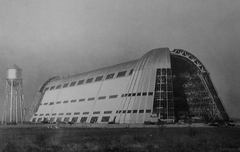 Hanger One
Hanger One
|
As excited as the Bay Area was to see the massive airships, the local interest in the construction of its storage hangar Hangar One - was almost as great. The hangar, 211 feet high, would be taller than all the buildings in the South Bay except one, the Bank of America tower in San Jose. The base also would be equipped with a massive nine-story mooring mast responsible for grabbing the giant airship by the nose and leading it in and out of the hangar on tracks. The hangar was still under construction when the Bay Area got its first glimpse of the kind of monster for which it was intended. Despite a veil of fog that had settled on the San Francisco Peninsula, it was a carnival-like scene at the Mountain View-Sunnyvale border on the morning of May 13, 1932. More than 100,000 people - enough to fill Stanford Stadium - packed the bayside fields where they huddled in cars and sat in bleachers set up by concessionaires. Vendors sold hot dogs, sandwiches and pies. Sixty-five state troopers were called in to handle the traffic on the still-uncompleted Bayshore Freeway where cars inched ahead four abreast en route to the site. The crowd had assembled by the bay to greet a Navy aircraft carrier that was due to dock any time that morning. But this new ship would not be arriving by water. Suddenly, about 7 a.m., the recently completed USS Akron, which would be based in Lakehurst, N.J., dropped ghostlike out of the clouds. The silver dirigible stretched across the sky, two and a half times the length of a football field. The crowd cheered. "It was a neverto-be-forgotten sight..." noted a Palo Alto Times story. This would be the first and last time the Akron would visit the base. Less than a year later on April 4, 1932, the "sky-queen" got caught in heavy storm winds and crashed off the Atlantic Coast, killing 73 of the 76 officers and crew on board. Among those lost was Admiral William Moffett. Eight days later, a somber crowd gathered at the base, and Sunnyvale Naval Air Station was commissioned. Acting Commanding Officer M.J. Walker concluded the ceremonies by giving the now-famous orders to a deputy officer named D.M. Mackey, "Enter in the log that the Sunnyvale station is placed in commission at 11: 30 a.m. Set the watches and pipe down."
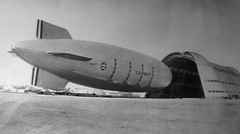 Hanger One open for the Macon
Hanger One open for the Macon
|
Given that the base was located in two Peninsula communities, the original name of the air base was supposed to be the Mountain View-Sunnyvale Naval Air Station. In fact, most of the base actually rests in Mountain View. But Naval officials in Washington, D.C. reportedly feared that the "mountain" in the title would create more safety concerns among Congressional leaders already jittery about the lighter-than-air craft program. In the end, the Mountain View portion was left off in favor of just "Sunnyvale" which gave East Coast officials an image of vast, wide-open areas with plenty of room for massive airships. Sunnyvale Naval Air Station now awaited the Macon. On April 21, 1933, the Macon, $2.5 million in the making, left Akron, Ohio on its maiden voyage. The entire craft, 785 feet long, was nearly twice as large as the famous Graf Zeppelin from Germany. Known officially as ZRS-5, the Macon was more modem and slightly faster than its sister ship, the Akron, ZRS-4, with a top speed of about 87 miles per hour. To the bewilderment of some, the craft was named the Macon, after the largest city in the Georgia district of Rep. Carl Vinson, chairman of the House committee on Naval Affairs. To those on the East Coast, the naming was considered a politically prudent move. The rigid airship was the product of the Goodyear-Zeppelin Co., a business jointly owned by the Zeppelin Company of Germany and the Goodyear Tire and Rubber Company. Unlike the blimps made famous by Goodyear today, the Macon had a hollow steel hull with three interior keels. The intent of the strong spine was to prevent the type of hull collapse that occurred with the Shenandoah. From the outside it looked and functioned much like a helium balloon. But on the inside, the ship was an open cavern of girders, cables and catwalks with few places where crewmen could not go.
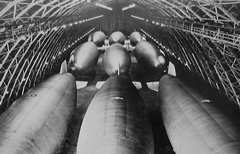 helium cells in the Macon
helium cells in the Macon
|
Before 1925, many lighter-than air craft operated on hydrogen. But the flammability of the gas proved to be very dangerous, as would be demonstrated on May 6, 1937, in Lakehurst when fire would kill 36 people aboard the German zeppelin Hindenburg. The Macon and Akron were kept aloft by non-burning helium contained in 12 large gelatin-latex cells inside the craft. The ship carried a large supply of additional helium and navigators were able to set the craft's altitude by releasing or increasing the gas. Inside the hull, the ship had eight large 560-horsepower engines driving outside propellers, one of the craft's few noisy operations. The propellors could be pointed up or down to control the ship during take-offs and landings. The Macon had accommodations for 100 officers and crew, including sleeping berths, a large messroom, a galley, and observation platforms at the nose and tail. Although rigid airships were never used commercially in the United States, the key advantage to such a mode of transportation was said to be its smooth, silent motion and its speed in long-distance journeys. In short, people did not get seasick on dirigibles.
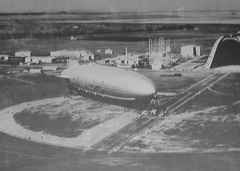 mooring the Macon
mooring the Macon
|
With nearly as much fanfare as marked the arrival of the Akron, the Macon cruised into the skies over Mountain View on Oct. 16, 1933, and docked without difficulty at its new home. "The new 785-foot air giant ... was free from the oil smudges that marred the Akron's appearance on its arrival here and seemed as silvery as if she had just taken to the air," noted a Palo Alto Times story. During the next 16 months, the Macon because a familiar and popular sight on the Peninsula, never failing to draw large crowds whenever it took off or landed. But there was much to be expected of this airship. A total of $5 million had been spent on the construction of the Macon and Akron, and the country was in the middle of the Great Depression. People in and out of the military wanted results. Almost immediately after arriving in Mountain View, the Macon was sent on maneuvers in the Pacific, but it was an inauspicious debut. During a mock battle, the ship was "shot down" twice in the first eight hours. In 1934, Lt. Commander Herbert Wiley, one of three survivors of the Akron crash, took command of the Macon. Determined to prove the Macon's value, he quickly developed and improved the ship's long-range detection and scouting system.
To put the system to test, the Macon left Moffett Field in July 1934 in an attempt to locate the cruiser Houston that was carrying President Roosevelt through the Panama Canal en route to Honolulu. Using only newspaper accounts of the president's departure time as a guide, the Macon raced 3,500 miles to a spot in the vast Pacific Ocean where Wiley had detennined they could find the Houston. They did. Aboard the cruiser, crewmen were shocked to see two scouting airplanes, the Sparrowhawks, come out of nowhere
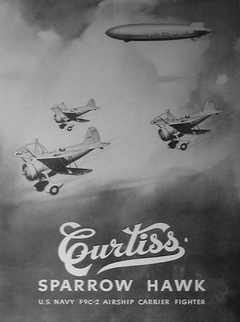 Sparrow Hawk planes
Sparrow Hawk planes
|
and circle the ship. Minutes later the Macon dramatically descended from the clouded sky and dispatched a plane that dropped bundles of the previous day's newspapers from San Francisco onto the Houston. The Fleet's admirals were not amused. Said Admiral Stanley, chief of naval operations, "We considered it a publicity stunt and that he (Wiley) had no business doing it." The president, however, was tickled. The stunt showed that the Macon was capable of the kind of scouting for which it was intended.Unlike other dirigibles of the time, the Macon was so massive that it also carried its own protection - five Sparrowhawk fighter planes which were stored in the aircraft's belly. The airplanes were released via a trapeze and a harness which lowered the planes through a T-shaped hole in the Macon's underside. Retrieving the planes, however, was a much more difficult process. Like a performing air stunt, the pilots had to equal their speed to that of the ship and "catch" the trapeze with a hook at the top of the plane. The harness would then be attached to the fuselage, and the aircraft would be raised. Despite the difficulty of the maneuver, the pilots, known as the "Men on the Flying Trapeze" had a flawless record on both the Akron and Macon.
The ship also came equipped with another scouting oddity known as a "spy" car. A cable would lower the telephone boothlike compartment from the airship to a point below cloud cover up to 1,000 feet. A crewman inside the spy car would then telephone back to the main control room relaying navigational information. The car acted as a sort of reverse telescope. The Macon and the Akron were built to be the chief scouts of the Pacific Fleet, providing long-range reconnaissance. In addition to providing protection for the "aircraft of the sky," the Sparrowhawks and the "spy" car were the ships' main eyes.
The Macon scouted for the Pacific Fleet eight times in all. But when the airship left Moffett Field on Feb. 11, 1935, to go on maneuvers off the coast of Southern California, repairs had not been completed to two tail fins that had been damaged several months earlier. Because of the need for the ship and the pressure to prove its value, Navy officials had decided to do the repair work piecemeal. Largely because of that decision, this would be the ship's 54th and final flight. The next day, as the ship was returning from its successful mission, it encountered storm winds off Point Sur, south of Monterey. Suddenly, a crosswind struck the ship with such force that the upper fins of the previously damaged tail were completely severed, sending shards of metal into the rear gas cells. In the control car, the steering wheel went slack and the navigators felt the tail drop. Wiley ordered the dumping of ballast and fuel. Crewmen hurried about the ship discharging anything they could to lighten the tail. Off-duty personnel were ordered to the nose to help bring that end down. But the ship was doomed.
After rising to nearly 5,000 feet, the Macon began to falI. Moments later the ship settled gently into the water, and the crew, clad in life jackets and prepared with life rafts - features that had not been available to many of those aboard the Akron - jumped into the water safely. Ships were quickly on the scene to pull the men out. A radioman was killed when he jumped from the failing ship, and another man was lost when he apparently tried to retrieve his belongings. But in all, 81 of the 83 aboard the Macon survived the crash, including "Lucky" Wiley. A commission set up to determine the cause of the ship's demise concluded that the blame belonged not to the crew, but to the Navy's refusal to repair the Macon's tail damage before it was sent on its ill-fated mission. The disastrous record of airships put the pressure on President Roosevelt to abandon the costly lighter-than-air program. The president responded by setting up a second commission, this one headed by Stanford Professor William F. Durand, to look into the future of airships. The panel found that dirigibles had been used for purposes for which they were not intended and that they had not been given a fair opportunity to prove their value to the military. The commission concluded that these lighter-than-air craft should be given another chance. They were not. The Macon was the nation's last rigid airship.
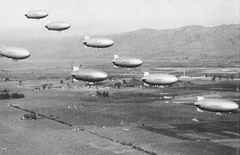 airships over Moffett 1944
airships over Moffett 1944
|
With the loss of the Macon also went the Navy's need for Sunnyvale Air Station, Moffett Field. On Oct. 25, 1935, just months after the demise of the Macon, the base was turned over to the War Department. Secretary of the War George H. Dem announced that the Navy was trading Moffett Field to the U.S. Army in exchange for the Army's North Island field in San Diego. Although Peninsula residents were saddened by the Navy's departure, the chambers of commerce along the Peninsula welcomed the Army with open arms. For the next three years the airfield became home for the 82nd Army Observation and the 9th Airbase Material squadrons. During this time, just one training blimp remained on the base, dwarfed within the cavemous Hangar One along with the Army's training aircraft. In 1938, elements of the Army's 18th and 20th pursuit squadrons came to Moffett, and the base's population ballooned to 5,000 enlisted men and 300 officers. Two years later, Moffett became the West Coast training center for the Army Air Corps, the predecessor to the U.S. Air Force. The purpose of Moffett now was to train air cadets. In March 1941, probably the most famous of these cadets arrived at the airfield - actor James Stewart. He left less than a year later after being commissioned a second lieutenant. The actor later rose to major general in the Air Force Reserves. During this period of greater use, a housing shortage grew so critical some enlisted men had to live in tents set up on the base. This situation necessitated the hasty construction of a series of wood buildings on the east side which became known affectionately as "Splinter City."
But all was to change by the events that occurred on Dec. 7, 1941. After the attack on Pearl Harbor, U.S. military leaders became concerned that the West Coast lacked the kind of aircraft needed to patrol for submarines and mines. This duty was to fall to the U.S. Navy. Even as the base remained under the jurisdiction of the Army, the Navy got to work rounding up some of the key personnel behind the old lighter-than-air craft program. Gradually they began to return to Moffett. In January 1942, the first of many blimps to be based at Sunnyvale Air Station, Moffett Field arrived unassembled by train.
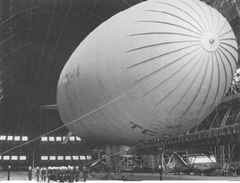 The old TC-14 was the first airship
The old TC-14 was the first airship
in ZP-32 at Moffett 1/31/1942
|
Eleven days later the LTA (lighter-than-air) squadron, ZP-32, was commissioned and had the distinction of launching the first LTA patrol of the Pacific Coast in World War II. Six of these blimps were on hand on April 16, 1942, when the home of the Macon was officially recommissioned as U.S. Naval Air Station Sunnyvale. Four days later it was renamed Naval Air Station, Moffett Field. Presiding over the ceremonies was the station's new commanding officer, Capt. D.M. Mackey, the man who had taken the first official order at the original 1933 commissioning of Moffett Field, logging in the now-famous command that concluded, "set the watches and pipe down." With the onset of war, Moffett Field was suddenly transformed from a base for training Air Corps cadets to the Naval Airship Training Command responsible for teaching personnel how to operate blimps. Within months as many as 20 blimps were on duty at the base. "The Santa Clara Valley is ideal for our lighter-than-air ships," said Rear Admiral John Greenslade, commandant of the Naval district in charge of the program. "Atmospheric conditions, terrain, proximity to other naval bases and nearness to desired areas for patrol as well as many other conditions make it the only place in the San Francisco Bay Area where a base should be placed."
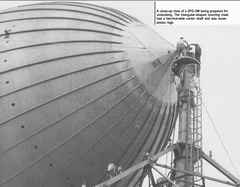 Mooring mast closeup
Mooring mast closeup
|
The non-rigid airships as well as hot air balloons were regular sights at the base. The shadows cast by the silvery airships were a far cry in size from the blackouts remembered from the days when the Macon passed overhead, but the blimps quickly proved their value. The great advantage to the airships was their ability to hover, drift and spot enemy craft and, like the Macon, they could maintain flight for long periods of time. Each blimp, built at a cost of $300,000, was 246 feet in length with a capacity of 375,000 cubic feet. The ships were powered by two motors and carried from seven to nine crewmen. Each also was armed with depth bombs and other weapons. Unlike the massive dirigibles, the blimps were not equipped with Sparrowhawks. They were, however, stocked with live carrier pigeons, which were used to dispatch messages from on high. At the "lighter-than-air school" sailors learned everything from how to rig and pilot blimps to how to maintain them. Part of the sailors' training also was the care and feeding of the carrier pigeons. In addition to training pilots, Moffett Field was responsible for patrolling the Pacific coastline.
After the bombing of Pearl Harbor, the fear of a West Coast invasion was high. Air raid drills and blackouts were as common as false sightings of enemy ships off shore. The patrols of Moffett crews played a critical role in easing the fears of a jittery public. Moffett's record for ship and mine detection was flawless if not altogether eventful. After the initial fear passed, the blimp pilots found a benefit of their patrols other than searching for ships that didn't exist. While scanning the Pacific Ocean, the blimp crews would spot schools of fish and report their locations to fishing fleets in San Francisco and Monterey. The activity became so popular that in January 1944, Moffett began holding official classes for pilots and crew on how to identify and recognize various schools of fish. These sightings were said to have saved fishermen much time and money.
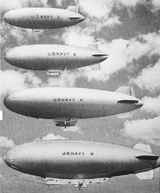 composite view of airship types
composite view of airship types
|
During this time, Moffett Field had become the nation's only air base devoted exclusively to lighter-than-air craft. The training for pilots was particularly intense. Before they could receive their official designation as a Naval Aviator (airship), aviation cadets had to first qualify as pilots of free balloons, similar to the hot air balloons of today. The massive interior of Hangar One, 198 feet high, proved a valuable area for this kind of training in any kind of weather. But even this monster structure was not sufficient to handle the demand for storage and training. In 1942, two more hangars were added to the base. Hangar Two was constructed in a rapid 372 days. Hangar Three went up in 208. Because of a wartime shortage of steel, they were both made primarily of wood and concrete. That same year Moffett Field became not only the place where blimp pilots were trained, but also where blimps were built. Moffett's newly established Assembly and Repair Department had the job of building training airships, L-type and regular K-type. This would prove to be the peak of the LTA program in U.S. history. In mid- 1942, the Navy designated Moffett a joint LTA and HTA (heavier than air) facility. At first the designation had little impact. But during the following two years, the HTA program grew as the LTA program began to decline.In January 1944, the last airship arrived at Moffett for assembly. Two months later, Moffett graduated its last training class for pilots and crew. And in August 1947, a blimp went down off the Cape of Mendocino. No lives were lost, but it would be the last flight for the LTA program at Moffett. That month, the last blimp at Moffett Field was deflated."
Links:
revised 2/22/02 by Schoenherr | WWII Timeline | WWII links